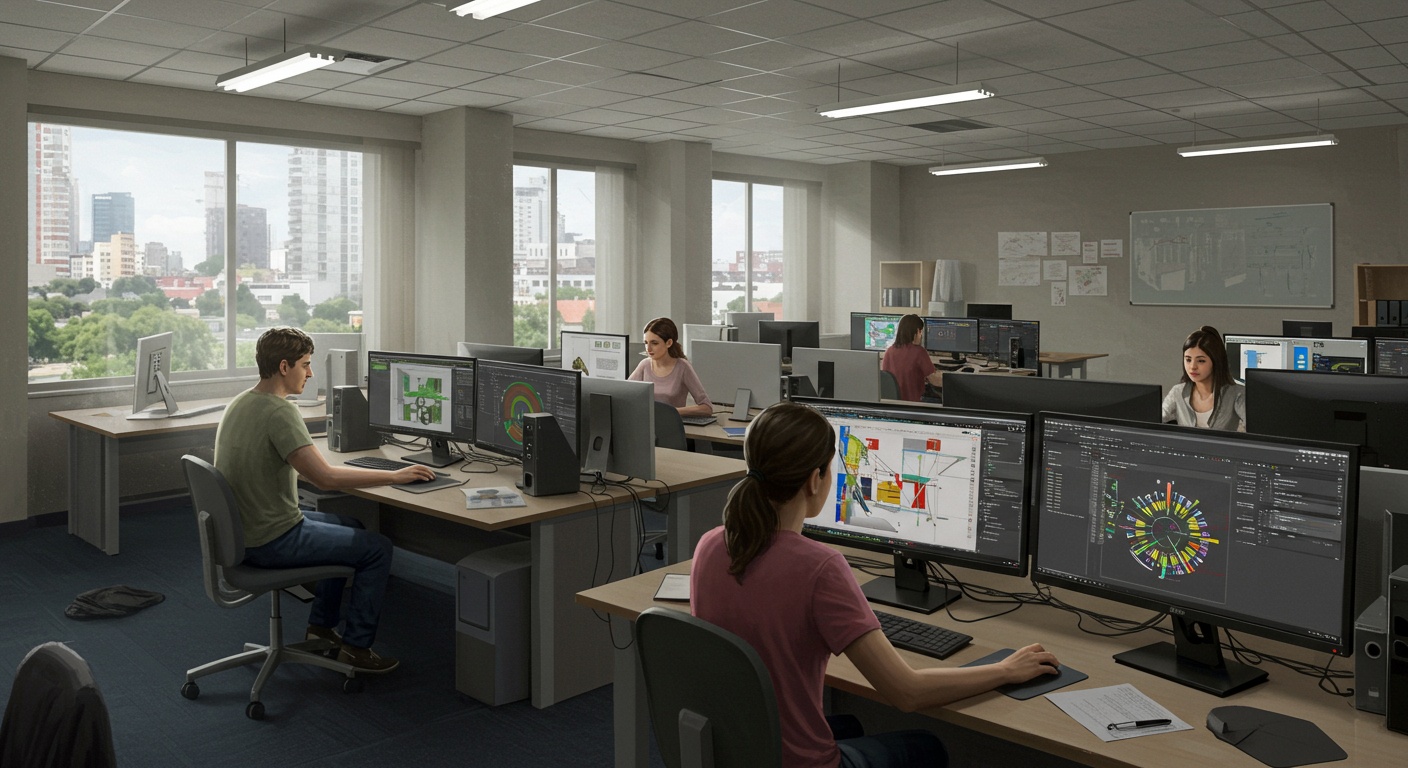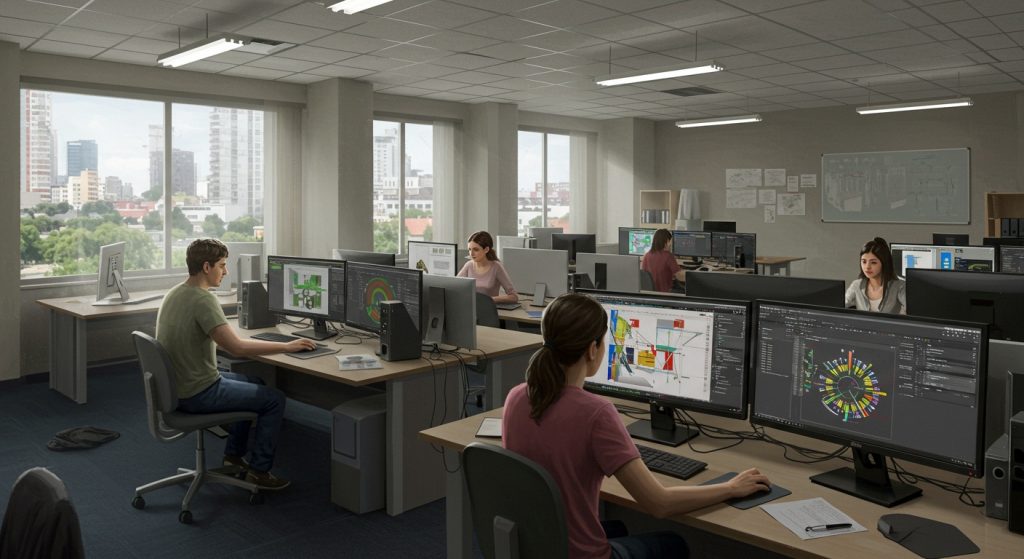The design landscape of 2025 demands fluency in a dynamic toolkit. Forget static mockups; clients now expect interactive prototypes built with Framer, responsive to AR/VR environments using Unity. Visualized with real-time ray tracing in Unreal Engine. Mastering these core platforms, alongside evolving standards in parametric modeling with Grasshopper for Rhino, is no longer optional – it’s the baseline. This curriculum equips you to not only meet current industry demands but also to anticipate the next wave of design innovation, ensuring your creative vision translates seamlessly from concept to tangible reality.

The Evolving Landscape of Design Software
The world of design is constantly shifting, driven by technological advancements and evolving creative needs. In 2025, a design education must equip students with a robust understanding of both established and emerging software tools. At institutions like RISD (Rhode Island School of Design), the curriculum reflects this dynamic landscape, emphasizing adaptability and a mastery of core principles alongside specialized software skills. It’s no longer enough to simply know how to use a tool; designers must grasp why and when to apply specific technologies to solve complex problems.
Core 2D Design Tools: Adobe Photoshop and Illustrator
Adobe Photoshop and Illustrator remain cornerstones of the 2D design world. Photoshop, primarily a raster-based editor, excels in photo manipulation, digital painting. Creating complex textures and effects. Illustrator, on the other hand, is a vector-based program ideal for creating logos, illustrations. Typography that require scalability without loss of quality.
Photoshop:
- Definition: A raster graphics editor developed and published by Adobe Inc.
- Key Features: Layers, masking, blending modes, retouching tools, filters.
- Use Cases: Photo editing, web design, UI design, digital painting.
Illustrator:
- Definition: A vector graphics editor developed and marketed by Adobe Inc.
- Key Features: Vector paths, shape tools, typography controls, gradient meshes, pattern creation.
- Use Cases: Logo design, illustration, print design, UI design (iconography).
Comparison:
| Feature | Photoshop | Illustrator |
|---|---|---|
| Image Type | Raster (pixel-based) | Vector (path-based) |
| Scalability | Limited; resolution-dependent | Unlimited; resolution-independent |
| Best For | Photo editing, realistic textures | Logos, illustrations, clean graphics |
In 2025, the focus isn’t just on mastering the basic features of these programs. Instead, the curriculum emphasizes advanced techniques like:
- Non-destructive editing: Utilizing smart objects and adjustment layers in Photoshop to maintain flexibility and avoid permanently altering original images.
- Advanced typography: Exploring OpenType features and variable fonts in Illustrator to create nuanced and expressive typography.
- Integration with other Adobe Creative Cloud applications: Seamlessly moving assets between Photoshop, Illustrator. Other tools like InDesign and After Effects.
Embracing 3D Design: Blender
Blender has emerged as a powerful and versatile open-source 3D creation suite. Its capabilities span modeling, sculpting, animation, rendering. Even video editing. What makes Blender particularly attractive is its accessibility and the large, supportive community surrounding it.
Definition: A free and open-source 3D creation suite.
Key Features:
- Modeling: Creating 3D shapes using polygons, curves. Surfaces.
- Sculpting: Deforming 3D models with brush-based tools, similar to working with clay.
- Animation: Rigging and animating 3D models using keyframes and motion paths.
- Rendering: Generating photorealistic or stylized images and animations from 3D scenes.
Use Cases:
- Product Design: Creating prototypes and visualizations of physical products.
- Animation and Film: Producing animated shorts and visual effects.
- Game Design: Developing 3D models and environments for video games.
- Architectural Visualization: Creating renderings of buildings and interior spaces.
At RISD in 2025, students are likely to learn:
- Procedural Modeling: Using Blender’s geometry nodes to create complex and customizable 3D models based on mathematical algorithms. This allows for more efficient design iterations and the creation of generative art.
- Real-time Rendering with Eevee: Leveraging Blender’s real-time rendering engine to create interactive visualizations and presentations. This is crucial for design reviews and client presentations.
- Integration with VR/AR Workflows: Exporting Blender models for use in virtual and augmented reality applications, allowing designers to create immersive experiences.
Real-world Example: Many product designers use Blender to quickly prototype and visualize their designs before committing to physical manufacturing. This allows for faster iteration and reduces the cost of physical prototypes.
User Interface and User Experience (UI/UX) Design: Figma
Figma has revolutionized UI/UX design with its collaborative, browser-based platform. It allows multiple designers to work on the same project simultaneously, making it ideal for team-based design workflows. Its intuitive interface and powerful features have made it a favorite among UI/UX professionals.
Definition: A web-based vector graphics editor and prototyping tool primarily used for UI/UX design.
Key Features:
- Vector Editing: Creating and manipulating vector graphics for UI elements.
- Prototyping: Creating interactive prototypes to simulate user flows and interactions.
- Collaboration: Real-time collaboration with other designers and stakeholders.
- Component Libraries: Creating and managing reusable UI components.
Use Cases:
- Website Design: Designing user interfaces for websites.
- Mobile App Design: Designing user interfaces for mobile applications.
- Web Application Design: Designing user interfaces for web applications.
- Prototyping: Creating interactive prototypes for user testing and validation.
In 2025, RISD students will likely focus on:
- Advanced Prototyping Techniques: Utilizing Figma’s advanced prototyping features to create realistic and interactive prototypes that simulate complex user interactions.
- Design Systems: Building and maintaining design systems in Figma to ensure consistency and scalability across different projects.
- Integration with Developer Tools: Seamlessly handing off designs to developers using Figma’s developer-friendly features and plugins.
Comparison: Figma vs. Adobe XD
| Feature | Figma | Adobe XD |
|---|---|---|
| Platform | Browser-based | Desktop application (with cloud collaboration) |
| Collaboration | Real-time collaboration | Coediting features. Not as seamless as Figma |
| Pricing | Free plan available, paid plans for more features | Part of Adobe Creative Cloud subscription |
| Operating System | Works on any OS with a browser | Windows and macOS |
Motion Graphics and Animation: After Effects
Adobe After Effects remains the industry standard for motion graphics, visual effects. Compositing. It’s a powerful tool for creating dynamic animations, adding visual effects to video footage. Designing engaging user interfaces.
Definition: A digital visual effects, motion graphics. Compositing application developed by Adobe Inc.
Key Features:
- Keyframing: Animating properties of layers over time.
- Compositing: Combining multiple video and image layers.
- Visual Effects: Adding effects such as particles, glows. Distortions.
- Motion Tracking: Tracking the movement of objects in video footage.
Use Cases:
- Motion Graphics: Creating animated titles, lower thirds. Other graphics for video.
- Visual Effects: Adding visual effects to film and television productions.
- Animation: Creating animated shorts and explainer videos.
- User Interface Animation: Designing animated user interfaces for websites and mobile apps.
In 2025, the curriculum will likely emphasize:
- Advanced Expressions: Using expressions (small snippets of code) to create dynamic and automated animations.
- 3D Integration: Integrating After Effects with 3D software like Cinema 4D and Blender to create complex visual effects.
- Virtual Reality and Augmented Reality: Creating motion graphics and visual effects for VR and AR applications.
The Importance of Adaptability and Lifelong Learning
While these software tools represent a core set of skills for designers in 2025, the most crucial ability is the capacity to learn and adapt. New software and technologies will continue to emerge. Designers must be prepared to embrace them. The curriculum at RISD and similar institutions emphasizes critical thinking, problem-solving. A strong foundation in design principles, which are transferable across different software platforms. Design is not just about the tools you use. How you use them to bring your creative vision to life. The key is to grasp the underlying design principles and apply them effectively, regardless of the specific software being used.
Conclusion
Mastering the design software taught at RISD in 2025 isn’t just about learning tools; it’s about cultivating a design mindset. Think of generative AI, like the evolving capabilities in Adobe’s Creative Suite, not as a replacement for creativity. As a powerful collaborator. Experiment with incorporating AI-generated textures into your 3D models in Blender, pushing the boundaries of what’s possible. Remember that the real magic happens when you combine technical skills with your unique artistic vision. Don’t be afraid to break the rules and develop your own workflow. For instance, I once accidentally created a stunning visual effect by misinterpreting a tutorial on Cinema 4D – happy accidents often lead to innovation! So, keep exploring, keep creating. Keep pushing the limits of what these tools can do. Your design journey is just beginning!
More Articles
AI’s Transforming Impact on Photography University Education: What to Expect
Essential University Photography Course Curriculum: A 2025 Guide
Spain’s Top Public Universities: A 2025 Ranking and Guide
Unlocking Scholarships: A Guide for International Students in Spanish Universities
FAQs
So, ‘Mastering the Tools’ at RISD in ’25… What software exactly are we talking about here? Is it just Photoshop and Illustrator?
Not just those classics, though they’re definitely still in the mix! We’re focusing on a broader suite. Think the Adobe Creative Cloud staples (Photoshop, Illustrator, InDesign, After Effects for motion graphics and video editing) plus key 3D modeling software like Blender and Rhino. We also touch upon some coding essentials for interactive design, focusing on languages like Processing and maybe even a little bit of Javascript.
I’m coming in with zero experience. Will I be totally lost?
Nah, you won’t be completely lost. The course is designed to cater to a range of skill levels. We start with the fundamentals and gradually build up to more complex projects. There’s a focus on hands-on practice and plenty of opportunities to ask questions. Plus, you’ll be surrounded by other students, so you can learn from each other too!
What kind of projects can I expect to be working on in ‘Mastering the Tools’?
Expect a diverse range of projects! Think branding exercises using Illustrator and InDesign, photo manipulation and digital painting with Photoshop, basic 3D modeling challenges with Blender. Maybe even a collaborative interactive installation using Processing. The goal is to give you a taste of different design disciplines and help you discover where your strengths lie.
Why these particular software programs? Are they just trendy, or is there a real reason?
Good question! These programs are selected because they’re industry standards and versatile. They provide a solid foundation for a wide range of design careers – from graphic design and web development to animation and product design. While trends come and go, mastering these core tools will set you up for success long-term. Plus, knowing these tools makes learning other software much easier later on.
Will I need to buy my own software licenses, or does RISD provide them?
RISD usually provides access to most of the software you’ll need for the course through student licenses. This will be confirmed at the start of the semester. Generally speaking, you’ll have access to the Adobe Creative Cloud and other relevant software on RISD computers and potentially your own devices too.
Okay. How deeply do we really dive into each program? Are we talking expert-level proficiency?
The aim isn’t necessarily to make you an absolute expert in every single program. We focus on building a strong foundation and developing your problem-solving skills. You’ll learn enough to be comfortable tackling a variety of design tasks and to continue learning on your own. Consider it like a really comprehensive introduction – you’ll gain a solid understanding and the confidence to explore further based on your specific interests.
What if I’m more interested in, say, UX/UI design? Will this course still be relevant?
Absolutely! While ‘Mastering the Tools’ isn’t solely focused on UX/UI, the skills you learn are incredibly relevant. Understanding visual design principles, working with design software. Even basic coding knowledge are all essential for UX/UI designers. This course will give you a solid base to build upon as you specialize.

